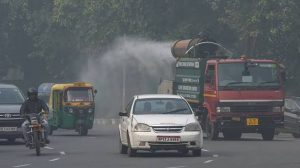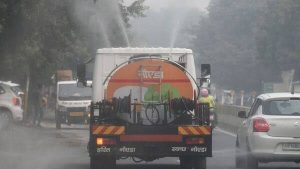Digital News Desk:
Delhi’s air quality improved to the “poor” category on Saturday, a notable development two days after the Diwali festivities, which had initially elevated pollution levels across the city. This year’s Diwali saw widespread use of firecrackers, which, despite a government ban, led to an increase in particulate matter, causing the Air Quality Index (AQI) to briefly hit “very poor” levels on Friday. However, meteorological conditions, particularly increased wind speeds, helped clear pollutants, pushing the AQI down to “poor” levels by Saturday.
Diwali’s Impact on Air Quality
Data from the Central Pollution Control Board (CPCB) indicated that the AQI in Delhi had surged after Diwali, largely due to increased PM2.5 and PM10 levels. PM2.5, consisting of fine inhalable particles, and PM10, larger particles, are both harmful to respiratory health. On Friday, several Delhi areas, including Anand Vihar and Ashok Vihar, recorded “very poor” AQI ratings. But by Saturday, air quality had improved, aided by warmer temperatures and wind patterns that helped disperse the smoke and pollutants accumulated from firecrackers and other Diwali-related activities.

Measures to Control Pollution
This improvement is primarily credited to meteorological factors, as winds from the northwest effectively carried away the dense pollutants that accumulated due to firecrackers and other Diwali activities. The Delhi government had deployed 377 teams to enforce the firecracker ban, yet many neighborhoods continued to use them, impacting AQI levels.
Government and environmental experts acknowledged that while air quality improved more quickly this year compared to past years, the ban on firecrackers was only partially effective. Despite significant enforcement efforts, firecracker violations were still widespread. Many Delhi neighborhoods flouted the restrictions, contributing to a temporary spike in pollution levels. Environmental authorities credit meteorological factors, rather than compliance, for the faster-than-expected improvement in air quality. According to meteorologists, the winds from the northwest helped disperse pollutants effectively, preventing Delhi’s air quality from slipping into the “severe” category, which had been a concern due to the city’s seasonal vulnerability to high pollution levels.

Weather Conditions and Improved Air Quality
The seasonal worsening of air quality in Delhi around this time of year is also compounded by crop stubble burning in neighboring states like Punjab and Haryana, as well as construction and vehicular emissions. Nevertheless, environmental experts, like those from the System of Air Quality and Weather Forecasting and Research (SAFAR), remain cautiously optimistic that continuing favorable weather patterns might prevent further spikes in pollution levels as winter approaches.
Delhi’s experience this Diwali underscores the ongoing challenges of regulating firecracker use and improving compliance with air quality measures. While conditions improved sooner than expected, authorities are reviewing enforcement approaches to ensure better adherence to pollution control measures during future festivals.
Ongoing Efforts and Long-Term Goals
While the drop to “poor” AQI is a short-term improvement, the overall pollution scenario continues to challenge authorities in the region, especially as stubble burning and colder temperatures worsen the air quality during this season. To counter long-term pollution issues, experts advocate for enhanced enforcement, a stronger crackdown on firecracker sales, and comprehensive policies addressing emissions from various sources, including vehicles and industries.

Delhi’s current situation underscores the ongoing need for effective environmental strategies, particularly during high-pollution events like Diwali, as well as for citizen compliance and government oversight to ensure sustainable air quality in the city.
You May Also Read: “Vajra Prahar” 2024: India-U.S. Forces Collaborate on High-Altitude Training in Idaho








